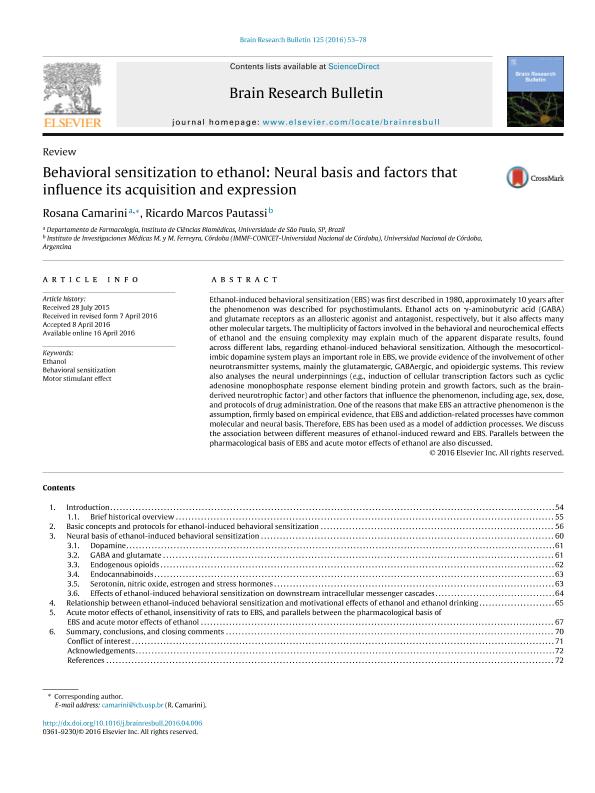Artículo
Behavioral sensitization to ethanol: Neural basis and factors that influence its acquisition and expression
Fecha de publicación:
07/2016
Editorial:
Pergamon-Elsevier Science Ltd
Revista:
Brain Research Bulletin
ISSN:
0361-9230
Idioma:
Inglés
Tipo de recurso:
Artículo publicado
Clasificación temática:
Resumen
Ethanol-induced behavioral sensitization (EBS) was first described in 1980, approximately 10 years after the phenomenon was described for psychostimulants. Ethanol acts on γ-aminobutyric acid (GABA) and glutamate receptors as an allosteric agonist and antagonist, respectively, but it also affects many other molecular targets. The multiplicity of factors involved in the behavioral and neurochemical effects of ethanol and the ensuing complexity may explain much of the apparent disparate results, found across different labs, regarding ethanol-induced behavioral sensitization. Although the mesocorticolimbic dopamine system plays an important role in EBS, we provide evidence of the involvement of other neurotransmitter systems, mainly the glutamatergic, GABAergic, and opioidergic systems. This review also analyses the neural underpinnings (e.g., induction of cellular transcription factors such as cyclic adenosine monophosphate response element binding protein and growth factors, such as the brain-derived neurotrophic factor) and other factors that influence the phenomenon, including age, sex, dose, and protocols of drug administration. One of the reasons that make EBS an attractive phenomenon is the assumption, firmly based on empirical evidence, that EBS and addiction-related processes have common molecular and neural basis. Therefore, EBS has been used as a model of addiction processes. We discuss the association between different measures of ethanol-induced reward and EBS. Parallels between the pharmacological basis of EBS and acute motor effects of ethanol are also discussed.
Palabras clave:
Behavioral Sensitization
,
Ethanol
,
Motor Stimulant Effect
Archivos asociados
Licencia
Identificadores
Colecciones
Articulos(INIMEC - CONICET)
Articulos de INSTITUTO DE INV. MEDICAS MERCEDES Y MARTIN FERREYRA
Articulos de INSTITUTO DE INV. MEDICAS MERCEDES Y MARTIN FERREYRA
Citación
Camarini, Rosana; Pautassi, Ricardo Marcos; Behavioral sensitization to ethanol: Neural basis and factors that influence its acquisition and expression; Pergamon-Elsevier Science Ltd; Brain Research Bulletin; 125; 7-2016; 53-78
Compartir
Altmétricas




